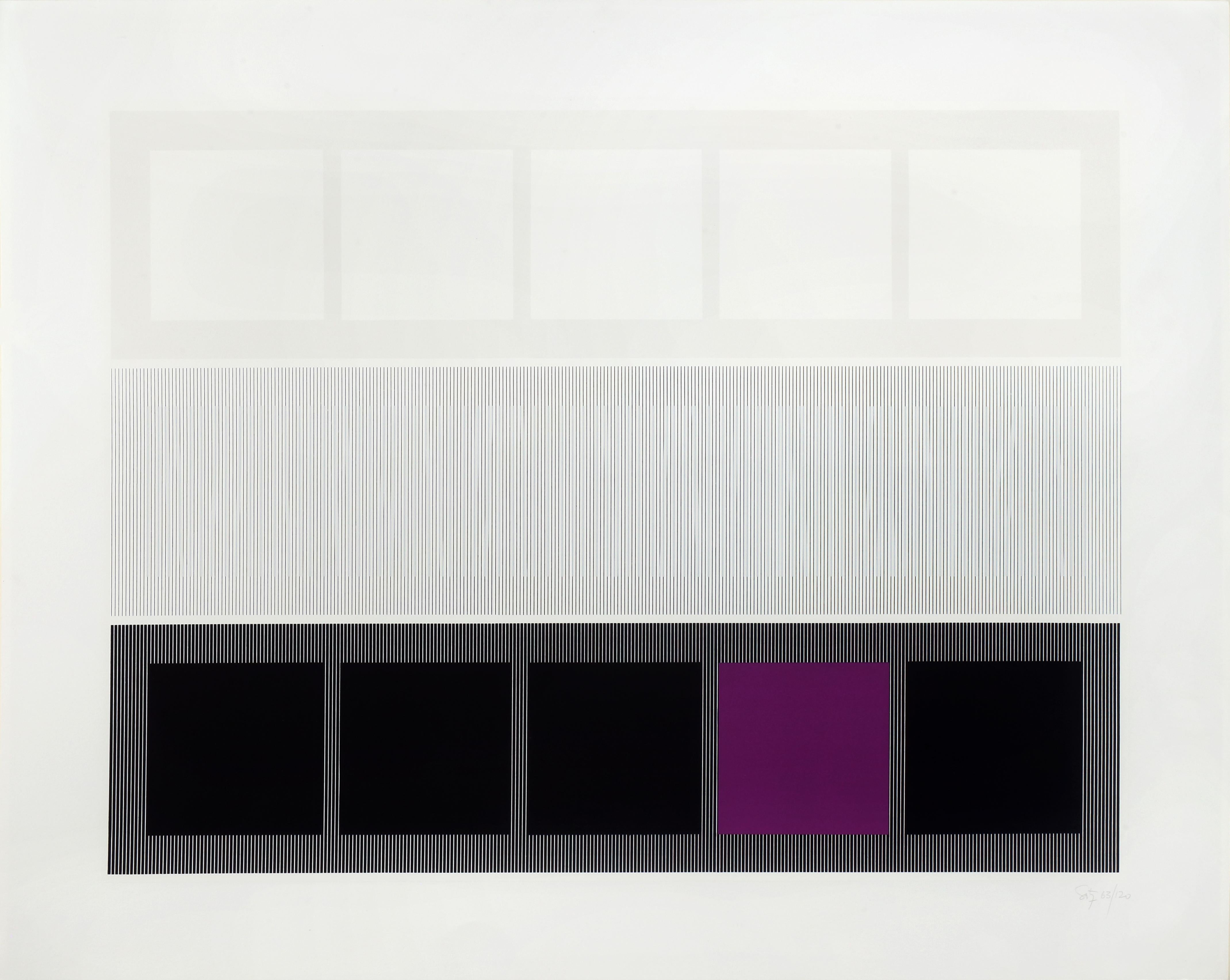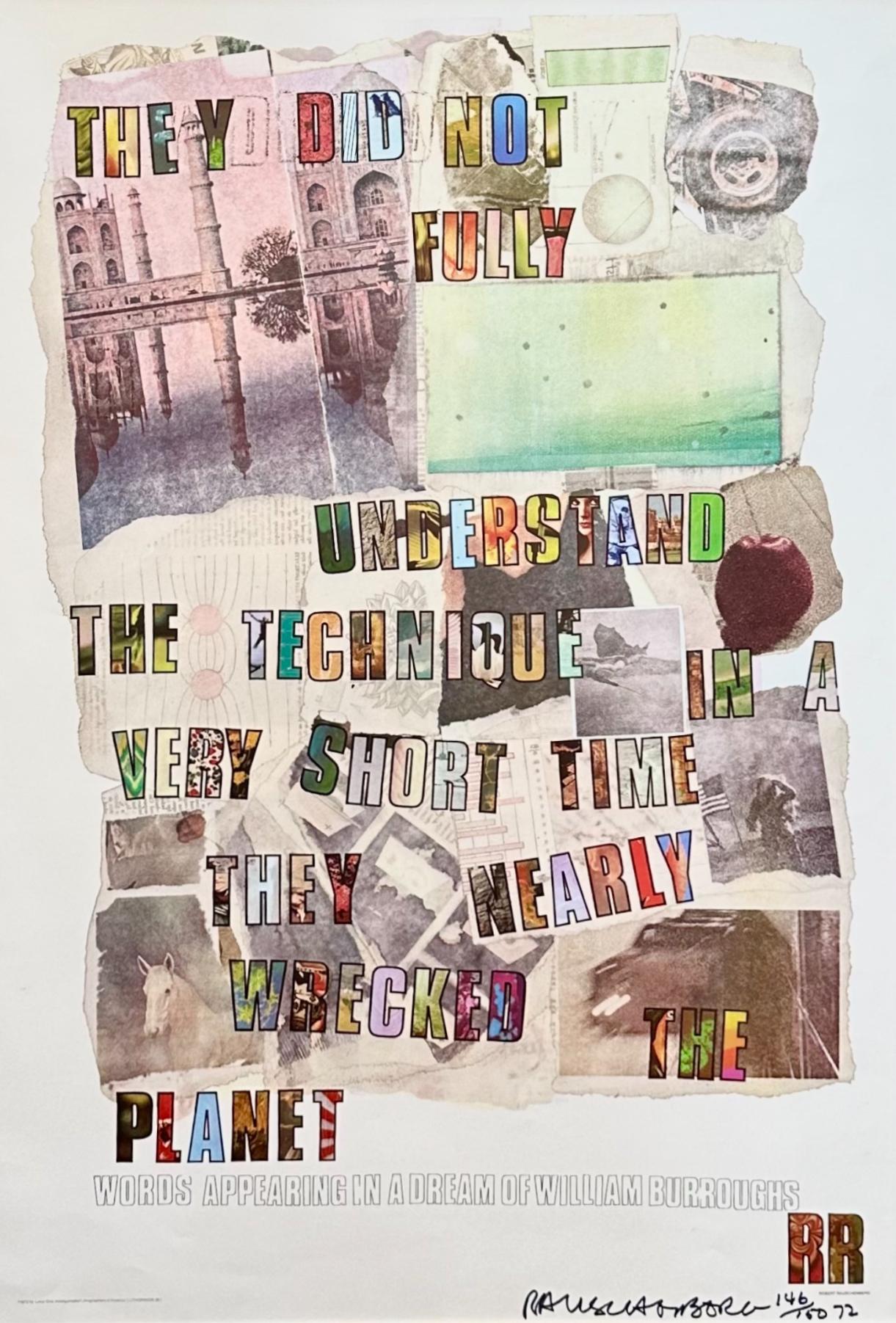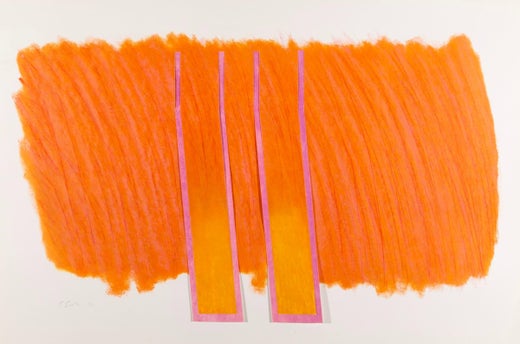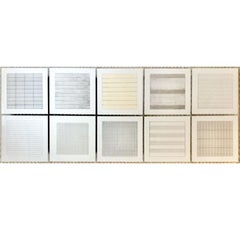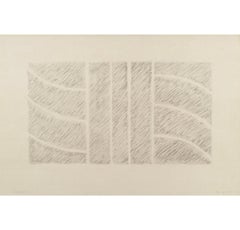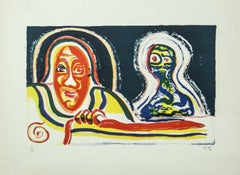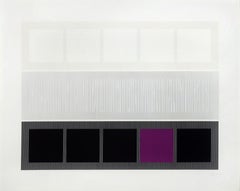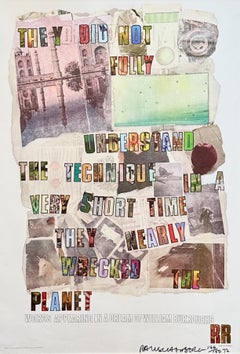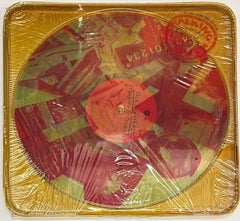Items Similar to Bright Orange Abstract 1970s Print with Pink, Bold Richard Smith Lithograph
Want more images or videos?
Request additional images or videos from the seller
1 of 6
Richard SmithBright Orange Abstract 1970s Print with Pink, Bold Richard Smith Lithograph1971
1971
About the Item
Sun Curtain by Richard Smith, 1971
Additional information:
Medium: lithograph on two sheets
64 x 92 cm
25 1/4 x 36 1/4 in
signed and dated in the plate
Charles Richard "Dick" Smith was an English printmaker and painter.
Smith was born in Letchworth, Hertfordshire, to Doris (née Chandler), a nurse and daughter of a chemical company director. He studied at Hitchin Grammar School and Luton School of Art. After military service with the Royal Air Force in Hong Kong, he attended St Albans School of Art followed by post-graduate studies at the Royal College of Art, London, from 1954-57. Smith shared a flat-cum-studio with Peter Blake in his second year at the RCA, and then again for two years after he left the college in 1957. When Terence Conran's Soup Kitchen opened on Fleet Street in the late 1950s, it featured a letter-collage mural by Smith and Blake. Michael Chow would later commission Smith to design installations for his restaurant in Los Angeles, and Chow and Conran have remained two of his biggest supporters.
In 1959 he moved to New York to teach on a Harkness Fellowship, staying for two years, where he produced paintings combining the formal qualities of many of the American abstract painters which made references to American commercial culture. The artist's first solo exhibition was at the Green Gallery. As his work matured it tended to be more minimal, often painted using one colour with a second only as an accent.
In trying to find ways of transposing ideas, Smith began to question the two-dimensional properties of art itself and to find ways by which a painting could express the shape of reality as he saw it. He began to take the canvas off the stretcher, letting it hang loose, or tied with knots, to suggest sails or kites - objects which could change with new directions rather than being held rigid against a wall, and taking painting close to the realm of sculpture. These principles he carried into his graphic work by introducing cut, folded and stapled elements into his prints; some works were multi-leaved screenprinting, and others printed onto three-dimensional fabricated metal.
Smith returned to England in 1963 - specifically East Tytherton, Wiltshire where Howard Hodgkin was a neighbour - and gained critical acclaim for extending the boundaries of painting into three dimensions, creating sculptural shaped canvases with monumental presence, which literally protruded into the space of the gallery. Evocative titles such as Panatella and Revlon, and cosmetic, synthetic colours alluded to the consumer landscapes of urban America which had proved so influential. He showed at the Kasmin Gallery, a venture between Kas and the Marquess of Dufferin and Ava in New Bond Street, throughout the 60s, more-widely known as David Hockney's first gallery.
After being awarded the Grand Prize at the 9th São Paulo Biennial in 1967 and important exhibitions at Kasmin in 1963, Tate in 1964, and Richard Feigen Gallery in 1966, Smith was invited to exhibit at the XXXV Venice Biennale as the official British artist in 1970. Smith was chosen by a committee of art experts, who were Director of Tate Norman Reid, art historian Alan Bowness, art collector David Thompson, the British Council’s Lilian Somerville and art historian Norbert Lynton. Smith taught with Richard Hamilton at Gateshead in 1965, where he met Mark Lancaster and Stephen Buckley, and again in 2000, becoming close to the artist and his wife, Terry.
By the late 1960s Smith's ambition to produce paintings which shared a common sensibility with other media, such as film and photography, began to wane and he focused on the formal qualities of painting. The freestanding installation Gazebo exhibited at the Architectural League of New York in 1966, and a tent project at the Aspen Design Conference of the same year, led to the development of his renowned ‘Kite’ paintings. First exhibited in New York in 1971, the traditional wooden supports of the canvases were replaced by aluminium rods and strings, allowing them to be hung freely in response to the surrounding architecture. Smith continued in the subsequent decades to construct site-specific works in public and private spaces often hanging from the ceilings or architectural supports. He resettled in Patchogue, New York in around 1977.
Smith was awarded the CBE in 1971. His work is held in the public collections of the Arts Council of Great Britain; The British Museum, London; Metropolitan Museum of Art, New York; The Museum of Modern Art, New York; Tate Gallery, London; Victoria and Albert Museum, London; Walker Art Center, Minneapolis; the Whitney, New York; MIT, Boston; Philadelphia Museum of Art; Museum of Contemporary Art, Chicago; Hirshhorn Museum and Sculpture Garden, Washington, DC. Private collectors included David Bowie.
“Where the first great abstract painters, including Kandinsky, Delaunay and Mondrian, derived their forms and colour harmonies essentially from nature, half a century later Richard Smith was at the forefront of a development in painting that took its cues not from the natural world but from visual stimuli already processed through culture. Smith’s joyful embrace of glamour and prismatic colour after the grey decade and a half of postwar austerity, brought him within the orbit of Pop Art at its very inception and assured him an important place in its early history.” Marco Livingstone, 2014
- Creator:Richard Smith (1931 - 2016, English)
- Creation Year:1971
- Dimensions:Height: 25.25 in (64.14 cm)Width: 36.25 in (92.08 cm)
- Medium:
- Period:
- Condition:
- Gallery Location:Kingsclere, GB
- Reference Number:1stDibs: LU2718214580622
Richard Smith
Charles Richard "Dick" Smith was an English printmaker and painter. He Attended St Albans School of Art followed by post-graduate studies at the Royal College of Art, London, from 1954-57. Smith shared a flat-cum-studio with Peter Blake in his second year at the RCA, and then again for two years after he left the college in 1957. When Terence Conran's Soup Kitchen opened on Fleet Street in the late 1950s, it featured a letter-collage mural by Smith and Blake. Michael Chow would later commission Smith to design installations for his restaurant in Los Angeles, and Chow and Conran have remained two of his biggest supporters. In 1959 he moved to New York to teach on a Harkness Fellowship, staying for two years, where he produced paintings combining the formal qualities of many of the American abstract painters which made references to American commercial culture. The artist's first solo exhibition was at the Green Gallery. As his work matured it tended to be more minimal, often painted using one colour with a second only as an accent. In trying to find ways of transposing ideas, Smith began to question the two-dimensional properties of art itself and to find ways by which a painting could express the shape of reality as he saw it. These principles he carried into his graphic work by introducing cut, folded and stapled elements into his prints; some works were multi-leaved screenprinting, and others printed onto three-dimensional fabricated metal. Smith returned to England in 1963 - specifically East Tytherton, Wiltshire where Howard Hodgkin was a neighbour - and gained critical acclaim for extending the boundaries of painting into three dimensions, creating sculptural shaped canvases with monumental presence, which literally protruded into the space of the gallery. Evocative titles such as Panatella and Revlon, and cosmetic, synthetic colours alluded to the consumer landscapes of urban America which had proved so influential. He showed at the Kasmin Gallery, a venture between Kas and the Marquess of Dufferin and Ava in New Bond Street, throughout the 60s, more-widely known as David Hockney's first gallery. Smith was invited to exhibit at the XXXV Venice Biennale as the official British artist in 1970. Smith taught with Richard Hamilton at Gateshead in 1965, where he met Mark Lancaster and Stephen Buckley, and again in 2000, becoming close to the artist and his wife, Terry. By the late 1960s Smith's ambition to produce paintings which shared a common sensibility with other media, such as film and photography, began to wane and he focused on the formal qualities of painting. First exhibited in New York in 1971, the traditional wooden supports of the canvases were replaced by aluminium rods and strings, allowing them to be hung freely in response to the surrounding architecture. Smith continued in the subsequent decades to construct site-specific works in public and private spaces often hanging from the ceilings or architectural supports. He resettled in Patchogue, New York in around 1977. Smith was awarded the CBE in 1971.
About the Seller
No Reviews Yet
Vetted Professional Seller
Every seller passes strict standards for authenticity and reliability
1stDibs seller since 2024
36 sales on 1stDibs
Typical response time: 11 hours
- ShippingRetrieving quote...Shipping from: Kingsclere, United Kingdom
- Return Policy
Authenticity Guarantee
In the unlikely event there’s an issue with an item’s authenticity, contact us within 1 year for a full refund. DetailsMoney-Back Guarantee
If your item is not as described, is damaged in transit, or does not arrive, contact us within 7 days for a full refund. Details24-Hour Cancellation
You have a 24-hour grace period in which to reconsider your purchase, with no questions asked.Vetted Professional Sellers
Our world-class sellers must adhere to strict standards for service and quality, maintaining the integrity of our listings.Price-Match Guarantee
If you find that a seller listed the same item for a lower price elsewhere, we’ll match it.Trusted Global Delivery
Our best-in-class carrier network provides specialized shipping options worldwide, including custom delivery.More From This Seller
View AllVariations on Six (Blue on Black) by Clifford Ellis, 1953
By Clifford Ellis
Located in Kingsclere, GB
Variations on Six (Blue on Black) by Clifford Ellis, 1953
Additional information:
Medium: lithograph
85 x 64.5 cm
33 1/2 x 25 3/8 in
Clifford Ellis was born in Bognor Regis, West S...
Category
20th Century Abstract Prints
Materials
Lithograph
Paintings and Drawings, by Agnes Martin 1974-1990 (Stedelijk), 1991
By Agnes Martin
Located in Kingsclere, GB
Paintings and Drawings, by Agnes Martin 1974-1990 (Stedelijk), 1991
Additional information:
Medium: complete set of ten lithographs on transparent vellum paper
each, 30 x 30 cm
11 3/4 x 11 3/4 in
Agnes Martin was an American painter who was born in Macklin, Saskatchewan, Canada, in 1912, and became a US citizen in 1940. Martin is perhaps most recognised for her evocative paintings marked out in subtle pencil lines and pale colour washes. Although restrained, her style was underpinned by her deep conviction in the emotive and expressive power of art. Martin believed that spiritual inspiration and not intellect created great work. ‘Without awareness of beauty, innocence and happiness’ Martin wrote ‘one cannot make works of art’.
In a career spanning five decades, Martin became known for her square canvasses, meticulously rendered grids and repeat stripes, though her lesser-known early works consist of experiments with mixed media and works on paper. Martin thought of her works as studies in the pursuit of perfection.
Martin spent many years working in New York, where she was part of a contemporary of artists such as Sol LeWitt, Ann Truitt, Donald Judd and Ad Reinhardt – with whom she was close friends. In 1967, shortly after Reinhardt died and just as Martin’s art was gaining acclaim, she left the city and continued her investigations into Buddhism and meditation. She wished to experience true solitude and used this period of quiet reflection to produce some of her most significant writing, whilst situated in sparsely populated and remote areas of the United States and Canada. In 1968 Martin resettled in New Mexico and began building an adobe and log house in a remote mesa. She lived there alone and without modern conveniences for several years. In 1973 she began creating work again.
Agnes Martin’s influence reaches globally and plays a hugely significant role in 20th Century art history. Whilst known as a pioneer of abstract painting, her work as well as her reclusive lifestyle have served as an inspiration to creative practitioners in diverse disciplines. Painters, photographers, writers – and many devotees from the words of fashion, architecture and graphic design revisit and rephrase her perspectival studies and fascination with geometry, the legacy of which can be seen in investigations into brevity of line and muted colour palettes. Artists such as Richard Tuttle, Ellen Gallagher...
Category
20th Century Abstract Prints
Materials
Lithograph
Hornsey, 1957 - Abstract Lithograph Print in Bright Red and Blue
By Gordon House
Located in Kingsclere, GB
Gordon House was born in 1932 in Pontardawe, South Wales. Early exposure to art on trips to the Glynn Vivian Art Gallery as a young boy inspired House towards creative endeavors and ...
Category
Mid-20th Century Prints and Multiples
Materials
Lithograph
Relief by Kim Lim, 1993
By Kim Lim
Located in Kingsclere, GB
Relief by Kim Lim, 1993
Additional information:
Medium: lithograph
51.3 x 76 cm
20 1/4 x 29 7/8 in
signed, dated and numbered in pencil
Kim Lim was born in Singapore and spent much of her early childhood in Penang and Malacca. After her schooling in Singapore, Lim knew that she wanted to become an artist, and at eighteen, she enrolled at St. Martin's in London, where she spent two years concentrating mainly on wood carving. She then transferred to the Slade, where taught by the etcher Anthony Gross and lithographer Stanley Jones, she developed a strong commitment to print making.
On journeys back to Singapore she stopped off in Europe and India, soaking up the art 'like a sponge'. These were the experiences that confirmed in her a lifelong predilection for things archaic, and for the flow and rhythm of Indian and South East Asian sculpture: " I found that I always responded to things that were done in earlier civilizations that seemed to have less elaboration and more strength." In Greece she was entranced by Cycladic sculpture. Of Chinese art she was moved most by early Shang bronzes, Han sculpture, Sung pottery...
Category
20th Century Abstract Prints
Materials
Lithograph
Bonjour(!) by Morris Kestelman, 1975
By Morris Kestleman
Located in Kingsclere, GB
Bonjour(!) by Morris Kestelman, 1975
Additional information:
Medium: lithograph in colours on wove paper
26 3/4 x 18 7/8 in
68 x 48 cm
signed and numbered 46/75 in pencil
Category
20th Century Abstract Prints
Materials
Lithograph
Shaded Grey by Kim Lim, 1993 - Minimalist Textural Print, White and Grey
By Kim Lim
Located in Kingsclere, GB
Shaded Grey by Kim Lim, 1993
Additional information:
Medium: lithograph
52.5 x 56 cm
20 5/8 x 22 1/8 in
signed, dated and numbered 20/20 in pencil
Kim Lim was born in Singapore and spent much of her early childhood in Penang and Malacca. After her schooling in Singapore, Lim knew that she wanted to become an artist, and at eighteen, she enrolled at St. Martin's in London, where she spent two years concentrating mainly on wood carving. She then transferred to the Slade, where taught by the etcher Anthony Gross and lithographer Stanley Jones, she developed a strong commitment to print making.
On journeys back to Singapore she stopped off in Europe and India, soaking up the art 'like a sponge'. These were the experiences that confirmed in her a lifelong predilection for things archaic, and for the flow and rhythm of Indian and South East Asian sculpture: " I found that I always responded to things that were done in earlier civilizations that seemed to have less elaboration and more strength." In Greece she was entranced by Cycladic sculpture. Of Chinese art she was moved most by early Shang bronzes, Han sculpture, Sung pottery...
Category
20th Century Abstract Prints
Materials
Lithograph
You May Also Like
Marcel Pouget original signed limited ed. lithograph
Located in Paonia, CO
Marcel Pouget (1923 -1985 ) painter, poet, choreographer and film maker was a member of the avant -garde group COBRA. This was a reactionary movement in search of free expre...
Category
Mid-20th Century Abstract Expressionist Abstract Prints
Materials
Lithograph
Untitled
By Jesús Rafael Soto
Located in Miami, FL
Jesus Rafael Soto
“Untitled”
Lithograph Ed. 63 of 120
29 x 23 in
Category
20th Century Kinetic Abstract Prints
Materials
Lithograph
The Dream of William Burroughs
By Robert Rauschenberg
Located in Naples, Florida
This is an Offset Lithograph in colors and was produced in 1972. The lithograph is hand signed by the artist, dated 72, and numbered 146/150 at lower right. It was dedicated in the j...
Category
Late 20th Century Abstract Abstract Prints
Materials
Paper, Lithograph
Robert Rauschenberg Talking Heads Speaking in Tongues (new/sealed)
By Robert Rauschenberg
Located in NEW YORK, NY
Rare unopened Robert Rauschenberg designed Talking Heads Speaking in Tongues:
In 1983, legendary pop artist Robert Rauschenberg designed the album cover for Talking Heads’ acclaimed...
Category
1980s Pop Art Mixed Media
Materials
Lithograph, Offset
Composition C n°III in Red, Blue and Yellow - Lithograph
By Piet Mondrian
Located in Paris, IDF
Piet MONDRIAN (after)
Composition II in Red, Blue and Yellow
Lithograph (8 colors)
Printed signature in the plate
Justified HC (Hors commerce)
Blind stamp of the editor in the marg...
Category
21st Century and Contemporary Abstract Geometric Abstract Prints
Materials
Lithograph
German Surrealism Abstract Surrealist Lithograph Hans Bellmer
By Hans Bellmer
Located in Surfside, FL
Hans Bellmer German (1902–1975)
Abstract Surrealist Lithograph
Souterrain No. 13 8 1944 Musée Jean Brun
Date: circa 1965
Hand signed and numbered in pencil Edition of 100
Size: 19.5 x 26.5 in.
Hans Bellmer ( 1902 – 1975) was a Polish born German artist, best known for his drawings, etchings that illustrates the 1940 edition of Histoire de l’œil, and the life-sized female sculpture mannequin dolls he produced in the mid-1930s. Historians of art and photography also consider him a Surrealist photographer.
Bellmer was born in the city of Kattowitz, then part of the German Empire (now Katowice, Poland). Up until 1926, he worked as a draftsman for his own advertising company.
Bellmer is most famous for the creation of a series of dolls as well as photographs of them. He was influenced in his choice of art form in part by reading the published letters of Oskar Kokoschka (Der Fetisch, 1925) and Surrealism. Bellmer's puppet doll project is also said to have been catalysed by a series of events in his personal life.
Hans Bellmer takes credit for provoking a physical crisis in his father and brings his own artistic creativity into association with childhood insubordination and resentment toward a severe and humorless paternal authority. Perhaps this is one reason for the nearly universal, unquestioning acceptance in the literature of Bellmer's promotion of his art as a struggle against his father, the police, and ultimately, fascism and the state. Events of his personal life also including meeting a beautiful teenage cousin in 1932 (and perhaps other unattainable beauties), attending a performance of Jacques Offenbach's Tales of Hoffmann (in which a man falls tragically in love with an automaton), and receiving a box of his old toys. After these events, he began to actually construct his first dolls. In his works, Bellmer explicitly sexualized the doll as a young girl (his work bears connection to the works of Bathus). Hirschfeld has claimed (without further argumentation) that Bellmer initiated his doll project to oppose the fascism of the Nazi Party by declaring that he would make no work that would support the new German state. Represented by mutated forms and unconventional poses, his dolls (according to this view) were directed specifically at the cult of the perfect body then prominent in Germany.
He visited Paris in 1935 and made contacts there, such as Paul Éluard, but returned to Berlin because his wife Margarete was dying of tuberculosis. He was part of the circle of Surrealist luminaries such as Man Ray, Marcel Duchamp, Max Ernst, Joan Miro, André Masson, René Magritte, Alberto Giacometti and Salvador Dali as well as women artists—such as Frida Kahlo, Dorothea Tanning and Leonora Carrington.
Bellmer produced the first doll in Berlin in 1933. Long since lost, the assemblage can nevertheless be correctly described thanks to approximately two dozen photographs Bellmer took at the time of its construction. Standing about fifty-six inches tall, the doll consisted of a modeled torso made of flax fiber, glue, and plaster; a mask-like head of the same material with glass eyes and a long, unkempt wig; and a pair of legs made from broomsticks or dowel rods. One of these legs terminated in a wooden, club-like foot; the other was encased in a more naturalistic plaster shell, jointed at the knee and ankle. As the project progressed, Bellmer made a second set of hollow plaster legs, with wooden ball joints for the doll's hips and knees. There were no arms to the first sculpture, but Bellmer did fashion or find a single wooden hand, which appears among the assortment of doll parts the artist documented in an untitled photograph of 1934, as well as in several photographs of later work.
Bellmer's 1934 anonymous book, The Doll (Die Puppe), produced and published privately in Germany, contains 10 black-and-white photographs of Bellmer's first doll arranged in a series of "tableaux vivants" (living pictures). The book was not credited to him, as he worked in isolation, and his photographs remained almost unknown in Germany. Yet Bellmer's work was eventually declared "degenerate" (entartete kunst) by the Nazi Party, and he was forced to flee Germany to France in 1938, where Bellmer's work was welcomed by the Surrealists around Andre Breton.
He aided the French Resistance during the war by making fake passports. He was imprisoned in the Camp des Milles prison at Aix-en-Provence, a brickworks camp for German nationals, from September 1939 until the end of the Phoney War in May 1940.
After the war, Bellmer lived the rest of his life in Paris. Bellmer gave up doll-making and spent the following decades creating erotic drawings, etchings, sexually explicit photographs, paintings, and prints of pubescent girls. In 1954, he met Unica Zürn, who became his companion until her suicide in 1970. He continued working into the 1960s
Cécile Reims (1927) has been drawing the world that surrounds her since her childhood in Lithuania, and subsequently in Paris, Jerusalem, and Barcelona. As a Jew, she had to go into hiding during World War II, and found herself at death’s door when she contracted tubercu- losis. Recovering from the disease, she felt she had to give meaning to her life as a survivor and she experienced a “conversion to art” as one is converted to a religion. Her encounter with the engraver Joseph Hecht in 1945 introduced her to the burin, an unforgiving tool which became her medium of choice. In her early years as an artist, she produced the mysterious Visages d’Espagne, Metamorphoses and Bestiaire de la mort series. But in order to support her work as an artist and to help Fred Deux (1924), whom she married in 1952, she suddenly gave a new twist to her career by turning to the interpretation of others’ work and engraving the drawings made by other artists. Cécile Reims filled this role with good humour and immense talent, as well as secretly collaborating with numerous artists working in the surrealist mode, such as Hans Bellmer, from 1966 to 1975, Salvador Dalí, from 1969 to 1988, Fred Deux, from 1970 to 2008, and Leonor Fini, from 1972 to 1995.
In 2004, the Bibiothèque Nationale de France held an important retrospective devoted to Cécile Reims, suddenly putting into the limelight a figure who had long been kept in the shadows. At that point it became essential to produce a catalogue raisonné of her miniature engravings...
Category
20th Century Abstract Abstract Prints
Materials
Lithograph
Recently Viewed
View AllMore Ways To Browse
Pink Green Print
Orange Tie
60s Metal Wall Art
Royal Albert Plate
Vintage Wall Tent
Design By Conran
Pink Bow Tie
English Soup Plates
Vintage Canvas Tent
Vintage Chandlers
Vintage Conrans
Sail Knots
Chandler England
Chandlers Pink
Wooden Curtain Rods
Vintage Metal Painters Ladder
Vintage Plakate Original
Vintage Posters Cuba Cigars

